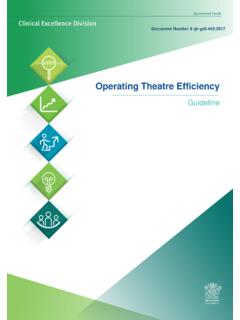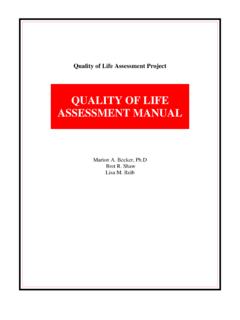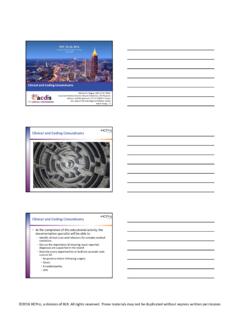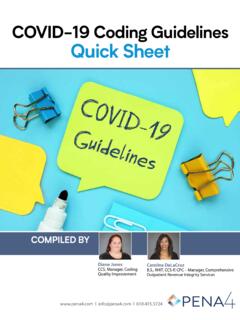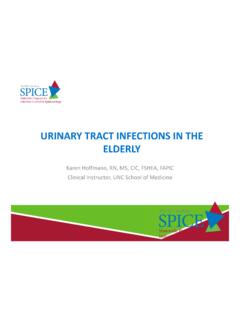Transcription of 2020 HEDIS Measure Tip Sheets - The Physician Alliance
1 Blue Cross Blue Shield of Michigan and Blue Care Network are nonprofit corporations and independent licensees of the Blue Cross and Blue Shield Association. 2020 HEDIS Measure Tip Sheets Table of Contents Adolescent Well-care Visits (AWC) Adult BMI Assessment (ABA) Antidepressant Medication Management (AMM) Appropriate Testing for Pharyngitis (CWP) Appropriate Treatment for Upper Respiratory Infection (URI) Avoidance of Antibiotic Treatment for Acute Bronchitis/Bronchiolitis (AAB) Cervical Cancer Screening (CCS) Childhood Immunization Status (CIS) Chlamydia Screening in Women (CHL) Comprehensive Diabetes Care Retinal Eye Exam (CDC-E) Flu Vaccinations for Adults Ages 18-64 (FVA) Follow-up Care for Children Prescribed ADHD Medication (ADD) Follow-up After Hospitalization for Mental Illness (FUH) Initiation and Engagement of Alcohol and Other Drug Abuse or Dependence Treatment (IET) Immunizations for Adolescents (IMA)
2 Medical Assistance with Smoking and Tobacco Use Cessation (MSC) Medication Management for People with Asthma (MMA) Persistence of Beta-blocker Treatment After a Heart Attack (PBH) Pharmacotherapy Management of COPD Exacerbation (PCE) Use of Spirometry Testing in Assessment and Diagnosis of COPD (SPR) Use of Imaging Studies for Low Back Pain (LBP) Prenatal Care (PPC) Postpartum Care (PPC) Transitions of Care (TRC) Weight Assessment and Counseling for Nutrition and Physical Activity for Children and Adolescents (WCC) Well-child Visits in the First 15 months of Life (W15) Well-child Visits in the Third, Fourth, Fifth and Sixth Years of Life (W34) One in a series of tip Sheets that look at key Healthcare Effectiveness data and Information Set measures, commonly referred to as HEDIS measures.
3 2020 HEDISM easure TipsAdolescent Well-Care Visits (AWC)Utilization and Risk Adjusted Utilization HEDIS Measure * HEDIS Measure descriptionThe percentage of adolescents who had at least one comprehensive well-care visit with a primary care provider or an OB/GYN provider during the measurement population (denominator)Members ages 12 to 21 as of Dec. 31 of measurement compliance (numerator)Evidence of a comprehensive well-care visit with a PCP or OB/GYN provider during the measurement of the visit in the medical record must include the date when the well-care visit occurred and evidence of all the following:Note: This Measure can only be met through appropriate coding and Members in hospice Members deceased during measurement yearHelpful HEDIS hints Services provided during inpatient, emergency department or telehealth visits do not meet criteria.
4 Preventive services may be rendered on visits other than well-child visits, but services that are specific to the assessment or treatment of an acute or chronic condition don t count toward the Measure applies to commercial members only. Health history Physical developmental history Mental developmental history Physical exam Health education/anticipatory guidanceDocumentation is crucial: Must be completed by either a PCP or an OB/GYN provider. PCP: Physician , pediatrician, nurse practitioner or Physician assistant who offers primary care medical services in settings such as general or family practice, internal medicine and pediatrics. OB/GYN: Physician certified as an obstetrician and gynecologist or who successfully completed an accredited program of graduate medical or osteopathic education in obstetrics and gynecology.
5 Health history: assessment of the member s medical history. Notation of allergies, medications or immunization status alone would not count. However, if all three (allergies, medications, immunization status) are documented, this would meet criteria. Physical developmental history: developmental milestones and assessment of whether the adolescent is developing skills to become a healthy adult. Notation of appropriate for age without specific mention of development or well-developed/nourished/appearing would not : Documentation of Tanner Stage/Scale meets criteria for physical developmental history for this Measure . Mental developmental history: developmental milestones and assessment of whether the adolescent is developing skills to become a healthy adult. Documentation of behavior appropriate for age meets criteria.
6 Notation of neurological exam or well-developed alone would not count. Physical exam: Vital signs alone or visits where care is limited to OB/GYN issues ( , prenatal or postpartum care) would not count. The purpose of including visits with OB/GYNs is to allow that provider type to perform the adolescent well-care visit requirements. Health education and anticipatory guidance: given by the health care provider to the member and/or parents, guardians in anticipation of emerging issues that a member and family may face. Handouts given during a visit without evidence of a discussion does not meet criteria. Information given regarding medications or immunizations or their side effects would not for codingCodes to identify Well-Care Visits: ICD10CM: , , , , , , , , , , , Z , Z 76.
7 2 CPT codes**: 99381-99385, 99391-99395, 99461 HCPCS: G0438, G0439 Resources1. Centers for Disease Control and Prevention. 2019. Information on Raising Healthy Children for Parents with Teens (Ages 12-19). Centers for Disease Control and Prevention (CDC). 2014. Youth Risk Behavior Surveillance United States, 2013. * HEDIS , which stands for Healthcare Effectiveness data and Information Set, is a registered trademark of the National Committee for Quality Assurance, or NCQA.** CPT codes, descriptions and two-digit numeric modifiers only are copyright of the 2019 American Medical Association. All rights portion of this document may be copied without the express written permission of Blue Cross Blue Shield of Michigan, except that BCBSM participating health care providers may make copies for their personal use.
8 In no event may any portion of this publication be copied or reprinted and used for commercial purposes by any party other than BCBSM. None of the information included herein is intended to be legal advice and, as such, it remains the provider s responsibility to ensure that all coding and documentation are done in accordance with all applicable state and federal laws and Cross Blue Shield of Michigan and Blue Care Network are nonprofit corporations and independent licensees of the Blue Cross and Blue Shield Feb. 17, 2020 One in a series of tip Sheets that look at key Healthcare Effectiveness data and Information Set measures, commonly referred to as HEDIS measures. 2020 HEDIS Measure TipsAdult BMI Assessment (ABA)Effectiveness of Care HEDIS Measure * HEDIS Measure description Percentage of members whose body mass index (BMI) was documented during the measurement year or the year population (denominator)Members 18 through 74 who had an outpatient visit during the measurement year or year compliance (numerator)BMI components must come from the same data source, but can be from any setting (outpatient, inpatient, ER, etc).
9 Medical record documentation must include the following:1. Date of Visit2. BMI documentation as follows: Members 20 years and older: must have BMI Value along with the weight. Member 18 and 19 years: must have BMI Percentile with the height and : BMI percentile plotted on an age-growth chart meets Pregnancy diagnosis in the current or previous year Members in hospice Members deceased during measurement yearcontinuedDid you know? An estimated of Michigan adults were obese in 2019, increased from in 2018. If the current trends continue, more than 44 percent of adults in every state could be obese by 2030. Obesity accounts for up to 10 percent of medical expenditures nationwide. Reducing BMI by 5 percent is projected to save every state between and percent on obesity-related health care Measure applies to both commercial and Medicare HEDIS hints Document a distinct BMI value.
10 Ranges and thresholds do not meet the criteria. For patients younger than 20 years old, document height, weight, and BMI percentile. Discuss weight loss techniques with your patient if BMI exceeds the expected value: Reinforce the importance of lifestyle changes such as being active or making dietary choices that lead to weight loss and improve overall health. Encourage the patient to set goals regarding his or her weight. Discuss weight loss medications for people with health problems related to excess weight. Educate on Obesity as a complex, multifaceted, chronic disease. Environmental, genetic, physiological, metabolic, behavioral, and psychological factors can all affect obesit y. Obesity s impact on an individual s overall health increases both morbidity and mortality rates. It also increases the risk of chronic conditions like diabetes, coronary heart disease (CHD), and cancer.

